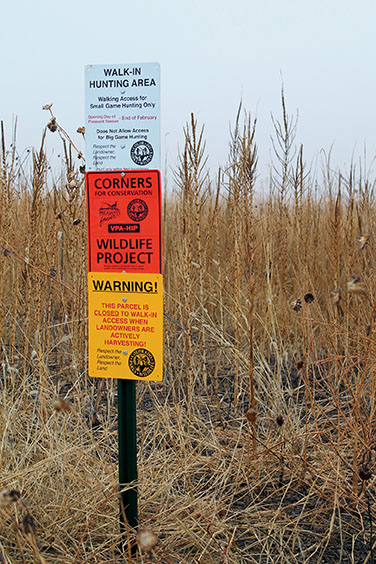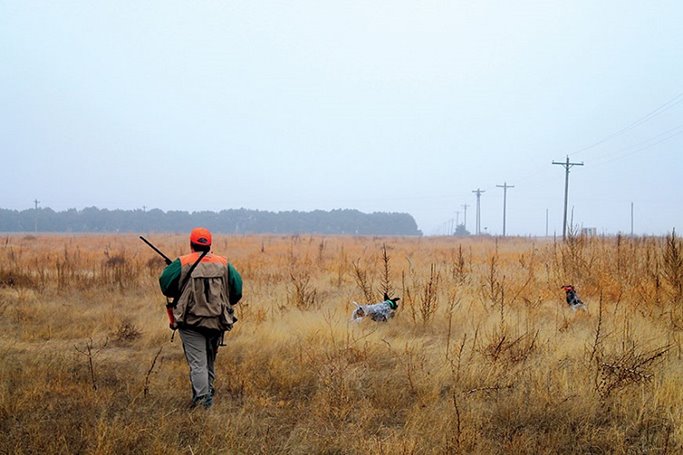Creating new pheasant habitat in the wake of CRP losses
By Christina Schmidt
Just two years into the Corners for Conservation (C4C) program in northeast Colorado, Jerry Miller, a
Pheasants Forever Farm Bill biologist, is hearing good things. He’s hearing from landowners pleased with the ease of sign up and the reliability of annual payments for their conservation efforts. He hears from hunters, excited about new hunting opportunities in previously inaccessible areas. But perhaps the most important feedback he receives is when he walks the enrolled fields and hears the calls of pheasants, bobwhites, meadowlarks, lark bunting and the busy hum of bees and pollinators.
“These acres are truly alive with all kinds of insects, birds, small animals and large animals like mule deer,” he said.
Corners for Conservation aka C4C
 C4C began in 2016 when a team of representatives from Pheasants Forever and Colorado Parks and Wildlife (CPW), alarmed by the loss of almost 50,000 acres of Conservation Reserve Program (CRP) fields in four of Colorado’s top five pheasant counties, developed a partnership to address the habitat loss and increase hunter access.
C4C began in 2016 when a team of representatives from Pheasants Forever and Colorado Parks and Wildlife (CPW), alarmed by the loss of almost 50,000 acres of Conservation Reserve Program (CRP) fields in four of Colorado’s top five pheasant counties, developed a partnership to address the habitat loss and increase hunter access.
The program works because of the geometric realities of farming on the high-desert plains. Land here is divided into 640-acre sections, and then further into 160-acre quarter sections that create a checkerboard pattern of corn, wheat, sugar beet and sunflower fields. While most crops are grown with natural precipitation, called dryland farming, some are watered by center-pivot irrigation systems which miss the outlying 7 to 8 acres in each corner of the square.
Some farmers plant the corners with less water-dependent crops, which may have a different planting and harvesting schedule, creating extra work and a challenge when maneuvering big equipment in the small, awkward spaces.
Recognizing the opportunity to create pockets of new wildlife habitat, the team sought funding to replant pivot corners with a mix of locally-adapted diverse plant species — pheasant habitat.
Participating landowners sign a five-year contract and, in return, receive an annual incentive payment and agree to sign up for CPW’s walk-in hunting access program. The landowner receives up to $75 per acre per year and an additional payment from the access program.
“We saw all this CRP disappearing and needed to do something to slow it, as well as show the benefit of more diverse plantings,” said Ed Gorman, CPW small game manager.
The first plantings took place in spring 2016 on 82 corners belonging to seven landowners. In 2017, 19 landowners participated with 120 corners planted, for a two-season total of 1,665 acres.
This year’s available slots filled within days, and participation is now limited only by funding. The program aims to have 400 corners planted by 2020.
“In the last 10 years, I’ve seen us hemorrhaging habitat,” said Bob Hix, Pheasant Forever’s Colorado regional representative. “In the face of this kind of reduction, 1,600 acres seems insignificant, but these corners are particularly valuable with high impact.”

C4C = Hunter Access
C4C also addresses a second concern for wildlife managers — declining hunter participation. Hix attributes part of that trend to the difficulty of securing hunting access in a landscape that is
98 percent privately-owned.
“There are a lot of people who will just never go knock on someone’s door to ask to hunt,” said Hix.
So instead, others have asked for them. Initial landowner contacts were made by Pheasants Forever Farm Bill biologists and chapter members. They explained the benefits and requirements of the new program and addressed landowner questions or concerns.
“You have to draw up something that works for landowners,” said Gorman. “It has to be attractive and straightforward.”
“Our contract is one page,” added Hix. “It says you will plant this particular mix, here are some basic rules, you sign it, we sign it and we’re done.”
Funding from Pheasants Forever chapters pays for five critical components of this unique partnership — equipment, labor, seed, landowner incentives and contributions to Farm Bill biologist salaries who largely handle landowner outreach. Pheasants Forever chapters from around Colorado invested $65,000 toward the C4C project in 2016 and helped purchase two $50,000 no-till drills in 2015 and 2016. Additional partners signed on as well, including the Muley Fanatics Foundation and the High Plains Land Conservancy.
With that initial local commitment and CPW Pheasant Habitat Improvement Program resources, CPW applied for and received a Voluntary Public Access and Habitat Incentive Program grant from the Natural Resources Conservation Service (NRCS), which included a request for additional funds to C4C.
Part of the program’s success can be attributed to the team’s strategic choices of corners on which to plant.
“The team realized that an isolated seven-acre corner would provide limited wildlife benefits, so we looked for landowners willing to enroll all four corners of the center pivot sprinkler and then started approaching neighboring landowners to eventually build a habitat complex,” explained Miller.
The team also chose a seed mix for maximum wildlife benefit that includes over 15 plant species, including native grasses, blanket-flower, prairie coneflowers, Rocky Mountain bee plant, coreopsis and yarrow.
“We were particularly interested in developing secure nesting habitat that would also serve as brood-rearing habitat,” said Miller. “Brood-rearing habitat is probably the most pheasant-limiting cover type on the landscape.”
The newly planted corners are already providing results for hunters. Hix said the high-quality habitat concentrates pheasants in those areas, giving new hunters or hunters without dogs, a good chance to harvest birds.
In fact, as Hix traveled the area on opening day of pheasant season, he encountered two hunters who had just completed a successful hunt on a corner, one of them harvesting a pheasant for the first time.
“Now, how do I clean this?” the hunter asked.
Hix gave the pair a quick tutorial on field dressing, a couple of Pheasants Forever hats and an invitation to that night’s banquet in Holyoke where more than 500 people were expected to attend to raise money to continue creating opportunities for hunters such as these.